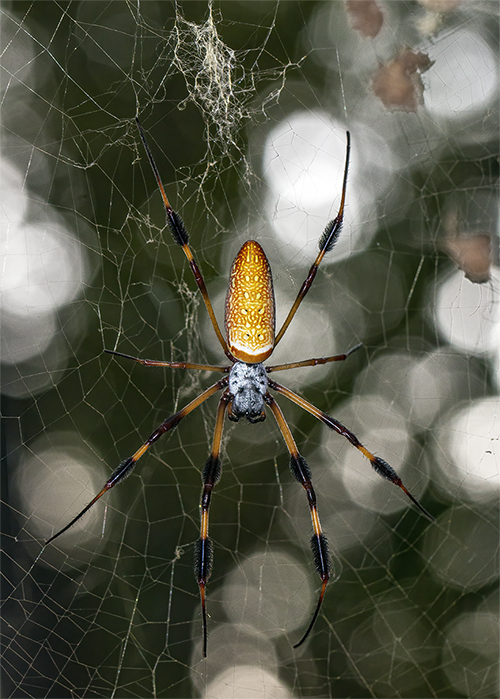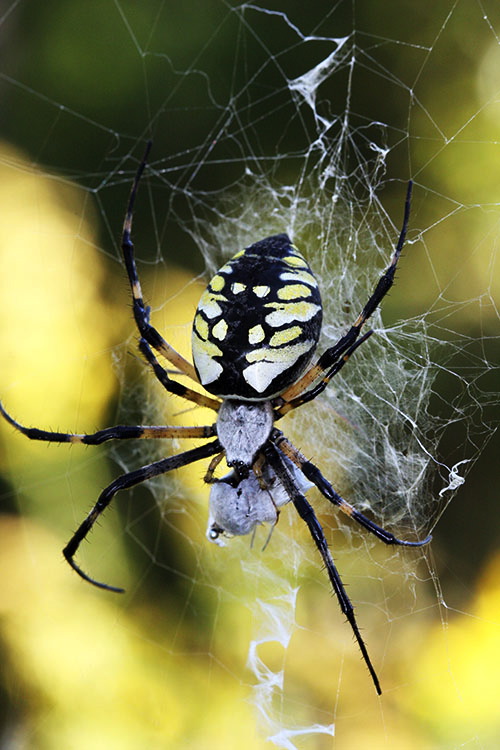- Established 1982 -HOME: www.hiltonpond.org
THIS WEEK at HILTON POND Subscribe for free to our award-winning nature newsletter (Back to Preceding Week; on to Next Week) |
ANOTHER NEW SPECIES; Lately we've been on a nice roll documenting new species for Hilton Pond Center, with our first-ever Chinese Mantid observed in September 2019 and a Giant Swallowtail butterfly the month before that. Then, early October brought another new organism we had never seen locally--yet another arthropod, but this time an eight-legger.
All text, maps, charts & photos © Hilton Pond Center We were a bit startled to encounter this new spider--not because we're arachnophobic--we're actually quite fascinated by spiders--but due to its size, its enormous web, and the fact we did not expect to see this species in the Carolina Piedmont, much less around Hilton Pond. It was a female Golden Silk Orbweaver, Nephila clavipes, which sometimes goes by Banana Spider or Calico Spider. (NOTE: The "golden silk" part of the spider's common name comes from the pale amber color of its silk--colorless in most spiders. The scientific name is derived from Greek words meaning "fond of spinning," plus "yellow" and "foot.") This truly is a large arachnid. Females can reach 3" in length--not counting legs at least that long--while minuscule males barely a half-inch INCLUDING legs. The female spins a massive web with a typical flattened, circular "orb" in the middle, but she also throws out random silk strands in all directions; these surround the orb, catching both insect prey and leaf litter as seen in our photo above. This particular web at Hilton Pond Center had an orb about 18" in diameter, with complementary strands of silk stretching far and wide. As with most orbweavers, the female in this species hangs head down in her web, the tip of each of her eight legs delicately poised on a single strand of silk (see photo above). There she waits until some unsuspecting insect hits the web, which vibrates and alerts the spider. She instantly dances to the appropriate spot, sinks her fangs into the victim, injects toxin to paralyze it, and begins to enclose the food item in a shroud of silk that makes escape impossible. Although the venom is toxic to prey, this big spider is not believed to bite people. (NOTE: Several even larger but unrelated Neotropical arachnids called Banana Spiders or Wandering Spiders--Phoneutria spp.--DO bite humans, sometimes with debilitating or even deadly effects.)
All text, maps, charts & photos © Hilton Pond Center One of the few Piedmont spiders that approaches the Golden Silk Orbweaver in size is the familiar Black-and-Yellow Argiope, Argiope aurantia (above), colloquially known as a "writing spider" because the female includes a scribble-like stabilimentum in her web. The abdomen of this spider is very different in shape and color from our new-found species at the Center, so the two could not easily be confused. (NOTE: The Golden Silk Orbweaver does not make a stabilimentum. It does bear distinctive bottle-brush tufts on its distal leg joints, as shown in the top photo; these are absent in the Black-and-yellow Argiope.) We have seen the Golden Silk Orbweaver on Fripp Island SC and elsewhere along the coast from Virginia to Florida. Its historical distribution in the Carolinas has been below the "fall line" that runs southwest through Raleigh-Durham NC and Columbia SC; in other words, it is NOT thought of as a spider of the Piedmont Region.
All text, maps, charts & photos © Hilton Pond Center According to Bakkegard & Davenport (2012), their map above depicts the "Range of Nephila clavipes in the continental United States (one 1965 Arizona record and one 1935 California record not shown). Dates indicate the earliest record for the spider. Solid line indicates the Fall Line which delineates the coastal plain from interior physiographic regions. Counties with no records are in white." Because the Golden Silk Orbweaver in a "warm-weather" spider, the authors suggest its gradual march northward and away from the coast might make it a good indicator species for climate change. We had hoped to get additional photos of our Golden Silk Orbweaver, whose web was supported by a triangle of silken strands that stretched from a gutter on the Center's old farmhouse to a hickory tree trunk, and back to the foundation bricks. It was an amazing example of spider engineering, but workmen installing a new roof arrived shortly after we discovered this silken mansion and tore down the web. We're hopeful they did not also kill the spider, which might be expected to live up to a year and make several egg cases that eventually would protect her newly hatched spiderlings. Web destruction also meant we weren't able to find out if a male was hiding somewhere, just out of reach of the female's poison fangs. Without him, of course, any eggs would likely be infertile. One final mystery involves how this very large Golden Silk Orbweaver female got to Hilton Pond Center in the first place-a locale quite far from its historical range. It just so happens we also host a thriving colony of Green Treefrogs, Hyla cinerea, another species prevalent in the Carolina Coastal Region but not originally found in the Carolina Piedmont. We have long suspected our Upcountry treefrogs hitched a ride in trucks transporting landscape plants from Lowcountry areas, so perhaps the same happened with the Golden Silk Orbweaver. It's certain neither species flew or walked, so some sort of human influence seems plausible, even likely. The important thing is that--if the climate warms and Bakkegard & Davenport are correct--Golden Silk Orbwweavers will be able to survive Piedmont winters on a regular basis and continue to extend their range past Hilton Pond and northward. Wouldn't it be ironic if people who don't heed the message sent by melting glaciers and starving Polar Bears would finally have to admit Planet Earth is heating up because a big ol' warmth-loving spider told them so. All text, maps, charts & photos © Hilton Pond Center
Checks also can be sent to Hilton Pond Center at: All contributions are tax-deductible on your Don't forget to scroll down for Nature Notes & Photos, |
|---|
|
"This Week at Hilton Pond" is written and photographed by Bill Hilton Jr., executive director of Hilton Pond Center for Piedmont Natural History
|
|
|
Please refer "This Week at Hilton Pond" to others by clicking on this button: |
|














 Please report your
Please report your Oct 15 to Mar 15:
Oct 15 to Mar 15: